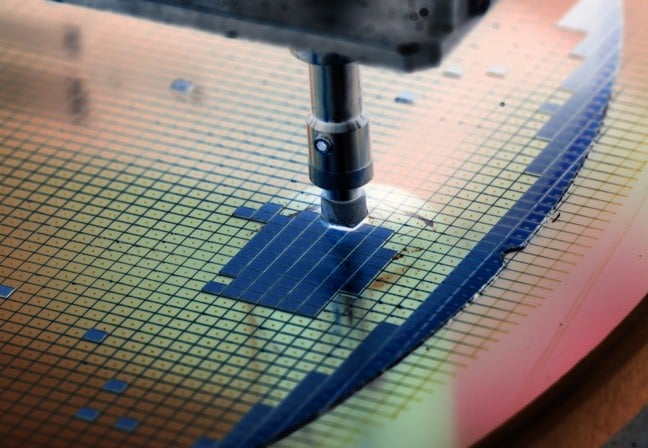Poor Semiconductor Revenues Can't Catch A Break: Just When You Thought It Was Safe To Go Back In The Wafer – Bam, Coronavirus


Gartner, tech's equivalent of Mystic Meg, has predicted that the semiconductor sector will struggle in 2020, thanks to everyone's least-favourite pathogen: the novel coronavirus discovered late last year. Worldwide revenue will decline 0.9 per cent year-on-year to $415.4bn. That's a revision on previous forecasts, which expected 12.5 per cent growth.
It could be worse. And, indeed, it would be, if not for the fact that the memory market remains strong, with signs of 13.9 per cent revenue growth this year, hitting $124.7bn.
The shining star is the NAND flash memory sector, which Gartner reckons will leap 40 per cent as manufacturers process orders made in the previous year.
"Companies are still paying the prices they negotiated for the first quarter, and, in fact, for the second quarter," Garner analyst Richard Gordon told The Reg. "Essentially, we've got half of the year where pricing has been locked in."
Another factor lending itself favourably to NAND's fortunes is the growing demand from hyperscale cloud clients, like those supporting home entertainment and remote working, which will need extra capacity to serve punters given the worldwide lockdown. This thirst from Netflix and Amazon, for example, will ultimately help cushion the blow from softening demand in other sectors, like the automotive industry, which Gordon cited as particularly vulnerable.
"There's usually 90-100 million vehicles produced each year. We've taken that [our forecasts] down to about 75 million, due to the lockdowns in the US and Europe," he said.
Government money
Gordon also expects demand to be boosted by government stimulus schemes designed to return the economy to growth. Ideally, this would be a Marshall Plan-style effort that would incorporate significant infrastructure spending, particularly around areas like telecommunications.
Memory represents just 30 per cent of semiconductor revenue. Things don't look as rosy for the rest of the market, which is expected to contract by 6.1 per cent year-over-year to $290.6bn.
Of course, forecasting is a bit of a dark art, and we live in uncertain times. The current global economic shutdown, as policymakers and government try to limit the spread of the disease, is unprecedented in the modern era*.
And there's a diverse array of predictions for how bad the economic repercussions will be. The most frightening comes from the St Louis Federal Reserve, which expects a worst-case scenario of 30 per cent unemployment in the US – which would be worse than the Great Depression. Others are comparatively milder, but still give pause for concern.
With that in mind, how can Garner really predict the future? Gordon explained that forecasting isn't so much of a science as an art.
"Forecasts are a pragmatic tool you can use for business planning," he said. "And obviously, all forecasts are, by definition, wrong, because they're all based on a set of assumptions. The chance of all your assumptions becoming true are remote.
"What we try and do is think through the assumptions and try and quantify what those mean for the market. So, in our case here, we're basing our views on the belief that governments won't want to destroy the economy.
"So, based on that, we can segment the market and look at things that are essential spending – like hyperscale and telecoms infrastructure, and healthcare – and things that are more discretionary spending, like consumer electronics. And from that, we can look at how these industries are going to recover, and from what time frame." ®
* Although it's worth noting that social distancing laws were introduced during the Spanish flu, particularly in the US. And they resemble the measures used today, with entertainment limited and shows running reduced opening hours.
Sponsored: How To Accelerate Brilliant Digital Experiences With Low-Code
From Chip War To Cloud War: The Next Frontier In Global Tech Competition
The global chip war, characterized by intense competition among nations and corporations for supremacy in semiconductor ... Read more
The High Stakes Of Tech Regulation: Security Risks And Market Dynamics
The influence of tech giants in the global economy continues to grow, raising crucial questions about how to balance sec... Read more
The Tyranny Of Instagram Interiors: Why It's Time To Break Free From Algorithm-Driven Aesthetics
Instagram has become a dominant force in shaping interior design trends, offering a seemingly endless stream of inspirat... Read more
The Data Crunch In AI: Strategies For Sustainability
Exploring solutions to the imminent exhaustion of internet data for AI training.As the artificial intelligence (AI) indu... Read more
Google Abandons Four-Year Effort To Remove Cookies From Chrome Browser
After four years of dedicated effort, Google has decided to abandon its plan to remove third-party cookies from its Chro... Read more
LinkedIn Embraces AI And Gamification To Drive User Engagement And Revenue
In an effort to tackle slowing revenue growth and enhance user engagement, LinkedIn is turning to artificial intelligenc... Read more

